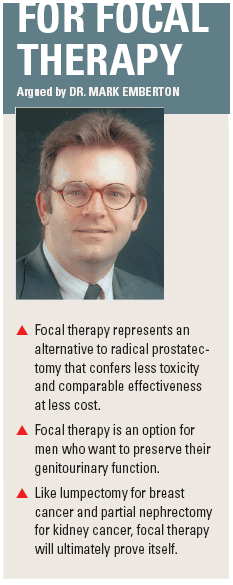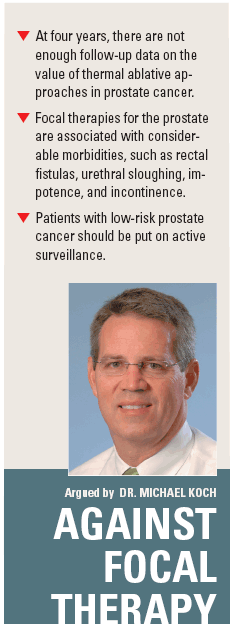Focal therapy for prostate cancer: An unproven technique or a reasonable alternative to radical prostatectomy?
In order for a new treatment modality to be considered efficacious, it needs to be evaluated by acceptable criteria and demonstrate an improvement on the natural course of the disease.
In order for a new treatment modality to be considered efficacious, it needs to be evaluated by acceptable criteria and demonstrate an improvement on the natural course of the disease. This has not been the case for focal therapy for prostate cancer.
Indeed, focal therapies for prostate cancer (see Table on page 29) are associated with considerable morbidities and have not been proven to cure prostate cancer, or at least reduce the morbidity of this disease, according to Michael O. Koch, MD, chairman of the department of urology at Indiana University in Indianapolis.
No so fast, countered Mark Emberton, MD, senior lecturer in oncologic urology at University College London. In Dr. Emberton’s estimation, focal therapy offers a definite alternative to radical prostatectomy for men who want active surveillance.
Dr. Koch and Dr. Emberton scrutinized the role of prostate focal therapy during a debate at the 2009 Genitourinary Cancers Symposium in Orlando.
No potential to cure prostate cancer
Studies of focal therapy suffer from lack of long-term data. “The longest published follow up with thermal ablative approaches to prostate cancer treatment is four years,” said Dr. Koch, who is also the John P. Donohue Professor of Urology at Indiana university. “At four years, the expected prostate cancer mortality would be approximately 4%. This number is too small for any of the published series to have adequate power and follow up to prove or disprove efficacy.”

While it may be premature to outright dismiss focal therapy, it is possible to say that the modalities are associated with morbidity, including rectal fistulas, urethral sloughing, impotence, and incontinence. “Focal therapies are not sham surgery in the sense that they do not treat the prostate,” he said. “They are sham surgeries, however, in the sense that they do not consistently ablate the entire prostate.”
He added that the available trials with focal therapy have been poorly controlled, have used inappropriate endpoints, and did not offer conclusive evidence of efficacy.
A two-year follow-up study by a group in Florida found that 94% of their patients (45 of 48) who were treated with focal cryoablation had stable PSA scores based on ASTRO criteria. All biopsy results were negative in the 24 patients with stable PSA scores who routinely had biopsies, and no local recurrences were noted in treated areas. In 36 of 40 patients who were potent preoperatively, potency was maintained to the satisfaction of the patient. All 48 patients in the study were continent (Urol Oncol 26:500-505, 2008).
“Since these modalities do have toxicity, they should be considered sham techniques until their potential to cure prostate cancer, or at least reduce the morbidity of the disease, can be demonstrated,” he said.
In order to believe that focal therapy is appropriate, it is necessary to believe that the cancer can be accurately staged within the prostate and that all of the significant tumors can be detected. In addition, one has to believe that focal therapy can consistently and effectively treat all the tumor foci. And finally, “you have to believe that treatment of the detected tumor foci will improve the morbidity or the mortality resulting from this disease and it should be better than what you can do with just surveillance,” he said.
Existing methods of selecting candidates for focal therapy leave much to be desired. Transrectal ultrasound with biopsy, as it is currently done, is a very poor way of detecting tumor foci, and radiographic imaging is not adequately sensitive, although its sensitivity is improving. “Nor can it tell us the grade of these small tumors,” Dr. Koch said.

He also questioned the effectiveness of current ablation techniques. “If you want to talk about focal therapy of the prostate, you ought to make sure you can ablate the entire prostate if you really think these treatments can effectively eradicate prostate cancer.”
Focal therapy has been suggested as an option for low-risk prostate cancer, but in Dr. Koch’s opinion, patients with these low-risk cancers should be put on active surveillance instead. Dr. Koch concluded that at this juncture, focal therapy has not been shown to effectively localize prostate cancer. “Are we ready to conduct a phase III trial with focal therapy? I would say no,” he said. Of course, “if payers decide to reimburse for focal therapy, it may very well become the leading treatment of low-risk prostate cancer.”
A major advance in prostate cancer treatment
Focal treatment of prostate cancer is definitely an idea whose time has come, Dr. Emberton told his audience. Prostate cancer is the only cancer for which the entire gland is removed or treated regardless of tumor location, he pointed out. But this approach has been abandoned in breast and kidney cancer. The same approach should be taken in prostate cancer as well, he said.
The wide array of treatment options available has given focal therapy a considerable boost, Dr. Emberton said.
“Technologies now exist that make focal treatment feasible. Cryosurgery, HIFU, photodynamic therapy, radiofrequency ablation, and brachytherapy can create localized necrosis within the prostate of a predetermined size in a relatively controlled manner,” he said.
While there may not be long-term data to support the use of these modalities in whole-gland therapy, all of these technologies are capable of destroying prostate tissue “with millimeter accuracy,” he said (Eur Urol 53:1194-1201, 2008).
Dr. Emberton acknowledged that focal therapy will never be suitable for all patients, just like partial nephrectomy is not suitable for all patients. He argued that it will be useful in men who put preserving genitourinary function at the top of their list.
“You can see here that having an option in the middle ground may serve the interests and address the utilities of a lot of patients we look after and treat,” he said.
The question that should be asked is, “In men with early prostate cancer, can focal or zonal therapy, vs standard therapy, active surveillance, or whole-gland radical therapy, confer improved tolerability, less toxicity, comparable or acceptable efficacy, and less cost?” he said.
Focal therapy represents a major advancement in prostate cancer treatment, Dr. Emberton said. The therapy is controversial now but so was lumpectomy for breast cancer and partial nephrectomy for kidney cancer at one time, he added.
Dr. Emberton acknowledged that long-term data on focal therapy are still needed. Nonetheless, its benefits are clear.
“Focal therapy virtually guarantees a man a normal genitourinary function by one to three months,” he said. “It is associated with the absence of clinically significant, clinically important, biologically important disease in all patients treated and evaluated to date, and it is associated with no evidence of disease recurrence.”
Prolaris in Practice: Guiding ADT Benefits, Clinical Application, and Expert Insights From ACRO 2025
April 15th 2025Steven E. Finkelstein, MD, DABR, FACRO discuses how Prolaris distinguishes itself from other genomic biomarker platforms by providing uniquely actionable clinical information that quantifies the absolute benefit of androgen deprivation therapy when added to radiation therapy, offering clinicians a more precise tool for personalizing prostate cancer treatment strategies.